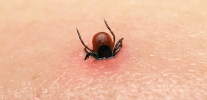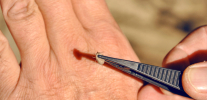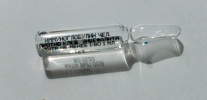
Fortunately, today almost everyone is well aware that ticks are carriers of dangerous infectious diseases, among which tick-borne encephalitis is especially notable. And when it detects on itself after a walked parasite, it is quite understandable that it may be contagious.
If a tick has just been removed from the skin, you can immediately take it for analysis to the laboratory. In a situation if the infection of the parasite is confirmed, it will only be necessary to inject immunoglobulin for emergency prevention of tick-borne encephalitis, and the disease will not develop with almost 100% probability.
Nevertheless, many people neglect the precautionary measures and begin to think about a possible infection not immediately, but only after some time, when that tick is no longer to be found, and prevention is carried out late (it is effective only in the first 3-4 days after the bite).
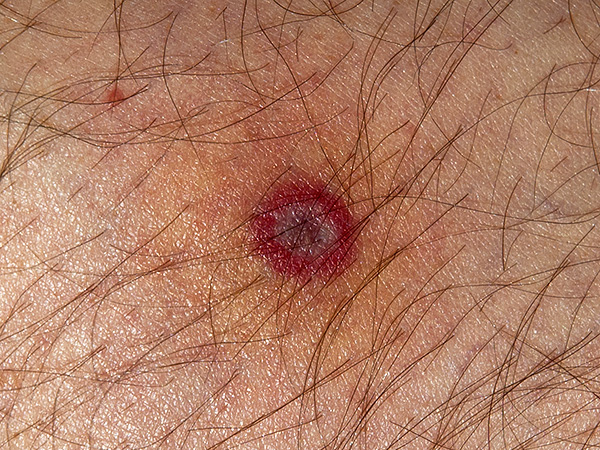
In this case, there is only one option - to observe the condition of the affected person and, at the first symptoms of the disease, go to the hospital and begin treatment. After being bitten by an encephalitic tick, if the organism is infected, the duration of the incubation period of tick-borne encephalitis in a person is several days - at this time, it is impossible to tell from external signs whether the disease develops in the body or not. And only the first characteristic symptoms usually unequivocally indicate that the disease has begun. Or, if the usual periods of the incubation period have passed, and there are no signs of the disease, you can be calm - no infection has occurred.
How long a bite victim needs to carefully monitor his condition and what nuances it is important to take into account will be discussed below ...
The duration of the incubation period of tick-borne encephalitis
It should be borne in mind that the duration of the incubation period of tick-borne encephalitis is not a constant value - it is individual for each person, and depends on the following factors:
- The number of viral particles that entered the body with a bite;
- The state of the immune system at the time of infection;
- The number of ticks, bitten person.

There were cases when encephalitis manifested itself three days after the bite, but there is also evidence of the development of the disease 21 days after the tick attack. On average, the incubation period of tick-borne encephalitis lasts 10-12 days, and after this period the probability of getting sick is significantly reduced.
People with weakened immunity should especially watch themselves - they are more likely to get sick after a tick bite. In people with strong immunity, even a reliable infection in the body is in most cases suppressed by the forces of the immune system, and the disease does not develop.
On a note
Also at risk are people who have recently arrived in a region endemic for tick-borne encephalitis. Old-timers in such areas may have immunity that has been formed in a natural way — with rare bites from ticks and ingestion of small amounts of the virus. New arrivals do not have such protection, and if they are bitten, the probability of being infected is much higher.
Age also plays a role, though not paramount.According to statistics, children are most susceptible to tick-borne encephalitis - in some areas their share is more than 60% of cases. This may be due both to the imperfect immunity of the child’s body as compared to adults, and to the banal fact that the child is more likely to be exposed to possible infection (while playing with peers) and is not so careful about his own protection from tick bites.

However, there is not a single age group whose members are not affected by tick-borne encephalitis at all.
As a result, after a tick bite, the condition of any affected person should be monitored for three weeks. If during this time the symptoms of tick-borne encephalitis have not developed, then you can be calm - the danger of getting sick has passed.
On a note
There is another way of infection with encephalitis - through raw milk of infected goats and cows, or the corresponding dairy products. Moreover, if goats get infected with the KE virus themselves, then the cows in the body reproduce it absolutely asymptomatically.
When eating infected milk, the incubation of the virus is on average faster, and the disease appears in about a week.

Now let's see what happens to the virus immediately after it enters the human body and how it develops during the incubation period ...
The penetration of TBE into the body and the initial stage of tissue damage
The tick-borne encephalitis virus is a microscopic spherical particle with a size of several hundred thousandths of a millimeter. When an infected tick bites a person, a huge number of such infectious agents enter the body along with the parasite's saliva.
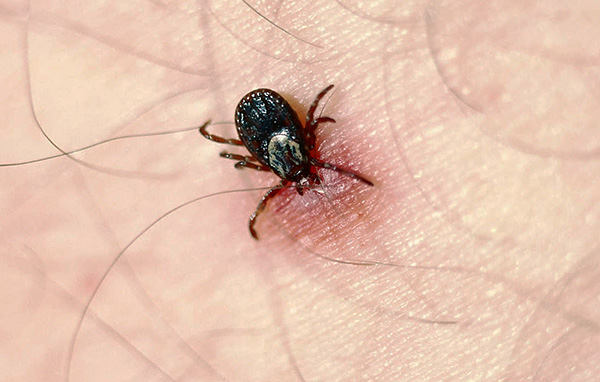
Once in the wound, viral particles (in fact, these are RNA molecules in the protein shell) from the intercellular space penetrate directly into the host cells. These are usually cells of the subcutaneous tissue and adjacent muscles (although this can also be the gastrointestinal tract when infected through dairy products).
When a viral particle enters the cell, it loses the membrane, and only RNA is inside the host cell. It reaches the genetic apparatus in the nucleus, is embedded in it, and in the future the cell will continuously produce along with its components also the proteins and RNA of the virus.
When an infected cell produces a sufficient amount of infectious particles, it can no longer perform its functions and function normally.Cells literally stuffed with viral particles are destroyed - as a result, a large number of virions enter the extracellular space and spread to other cells, and the decay products of a dead cell (and partly antigens of viral particles) cause inflammation. During the incubation period, the number of viral particles in human tissues is constantly and very rapidly growing.
The photo below shows how tick-borne encephalitis virus particles look like under a microscope:
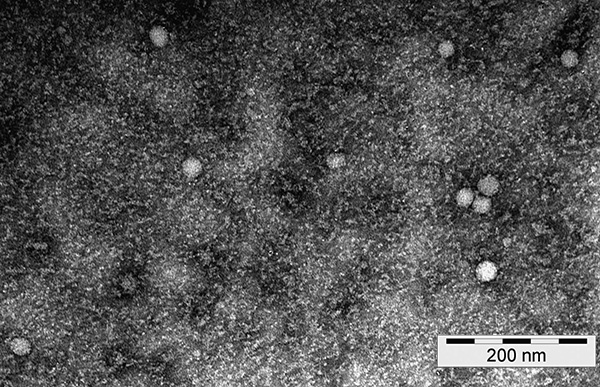
If the immune system of an infected person is strong enough, then it quickly identifies the antigens of the virus as dangerous, and begins to produce antibodies that bind viral particles, preventing them from infecting new cells. In this case, no symptoms of the disease will not appear - gradually the infection will be completely suppressed. But if antibodies are not produced (for example, the immune system does not identify the virus as a dangerous structure for the body), or there are not enough of them, then the viruses pass into the bloodstream and with it are spread throughout the body.
Initially, tick-borne encephalitis affects and destroys the so-called reticuloendothelial cells that perform a protective function.However, three days after infection, the virus is able to penetrate the central nervous system.
It is the brain that is the most favorable place for the reproduction of the virus - and here it works along the same lines, destroying cells and infecting new ones. But if the subcutaneous tissue is quickly restored when damaged, then the nerve cells are deprived of this ability. This and dangerous damage to the brain for any organism - the brain cells and the dura mater are not restored for a long time, and their damage leads to permanent violations of the state of health.

Despite the fact that in the classical case, encephalitis begins rather abruptly and unexpectedly, sometimes in the incubation period, changes in the state of health occur - the so-called prodromal symptoms. These include increased fatigue, weakness, drowsiness, poor appetite, general malaise. These are the first signs that an infection has happened.
On a note
In most cases, the infection goes unnoticed, and the disease takes an erased asymptomatic form. One can only guess about infection by the presence of antibodies in the blood of an apparently perfectly healthy person.
When the quantity of a multiplying virus begins to interfere with the normal functioning of the body, the first symptoms of the disease appear. If tick-borne encephalitis in this case corresponds to the Far Eastern subtype, then heavy lesions of the nervous system will occur rather quickly. Due to the degradation of nerve cells, epileptic seizures, muscle weakness and atrophy, paralysis may occur.
Mortality in patients in the Far East is quite high - this is a quarter of all cases of the disease. In Europe, the probability of death from encephalitis is much lower - only 1-2% of patients die.
Is the person infected during the incubation period?
At present, only two possible ways of tick-borne encephalitis infection are known - through the bites of infected ticks, as well as through milk and dairy products from infected goats and cows. If a person has tick-borne encephalitis, then he is not contagious to others. This concerns both the incubation period and the time of the most severe manifestations. The disease will not be transmitted when communicating (airborne), touching or through the mucous membranes.
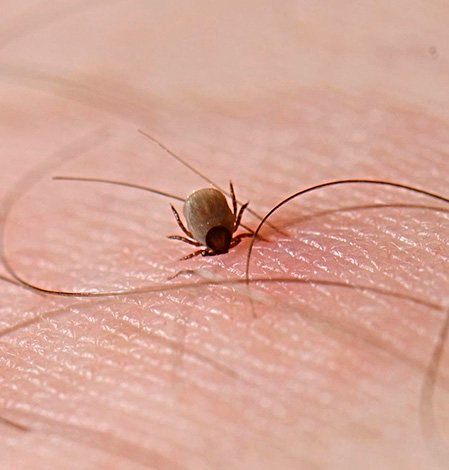
The same applies to pets - from a sick dog,which the tick infected, the owner cannot get the infection (it is useful to keep in mind that dogs in most cases are infected with ticks not by encephalitis, but by piroplasmosis).
So you can not worry about the danger of a tick-bitten person to others - the transfer of CE from person to person is simply impossible. Even in the case of infection, a person will not be dangerous for his relatives, you can communicate with him, stay in the same room and take care of him - the virus will not be transmitted by airborne droplets or by contact.
The first symptoms of the disease, which should pay attention
Watching the condition of an adult or a child who has suffered from a tick bite, one should pay attention to even a slight deterioration in health. Fatigue during the several days of the incubation period may already be one of the first prodromal symptoms of the disease.
On a note
People are often frightened to find that the tick bite has turned red and has begun to itch. However, itching and redness themselves are not yet signs of an impending disease — this is just a natural skin reaction to penetration of the parasite's saliva into the wound. So, it is unreasonable to diagnose CE (or tick-borne borreliosis) only according to these signs.

As a rule, tick-borne encephalitis begins abruptly. Often, patients can even name a specific time when they became ill. Classic first signs of the disease:
- The temperature rises sharply;
- Observed progressive headaches;
- A puffy face appears;
- Sometimes there is severe nausea and vomiting.
Such primary symptoms are characteristic of a relatively mild European subtype of encephalitis. For the more severe Far Eastern variant, in addition to the above manifestations, already at the onset of the disease, double vision, difficulty in speaking and swallowing, and urination are characteristic. Pathologies of the nervous system can be immediately observed - for example, a deterioration in the mobility of the neck muscles. Patients are very apathetic and lethargic, any communication increases their headache and gives even greater discomfort. In the future, these symptoms only intensify, especially without the time of treatment started.

It is especially dangerous if signs of brain damage begin to appear immediately. Difficulty of movement, seizures and convulsions may indicate a severe form of the disease, which requires urgent hospitalization.However, in the same way, any progressing symptom should be a signal for immediate admission to the hospital.
The doctor's help is no less important in the relatively “light version” of tick-borne encephalitis (European). This is absolutely not a disease in which you can only rely on the strength of your body. Vitamins, exercise and fresh air, of course, are useful, but they will not definitely cure tick-borne encephalitis. Self-medication and delay for this disease are absolutely unacceptable.
Sometimes there are situations when the immediate delivery of a person to a medical facility is impossible. In such cases, you need to place the bed of the patient in a darkened, but well-ventilated room. It is recommended to give him plenty of water. Food should be homogeneous so as not to cause an extra headache by chewing. If absolutely necessary, pain medication can be used. Both at the very beginning of the disease, and then it is necessary to provide the sick person with maximum physical, mental and spiritual peace.
On a note
When transporting to a hospital, it is important to position the person comfortably in the car to reduce shaking.The car at the same time need to drive at low speed, avoid sharp turns. It should be noted that the more time passes from the onset of the disease, the harder the patient tolerates any movement. Therefore, when the first symptoms occur, you should contact the doctor as soon as possible.
Further development of tick-borne encephalitis and its possible consequences
The high temperature at which the disease usually begins is kept by the patient for about a week after the end of the incubation period. But this period can be up to 14 days.
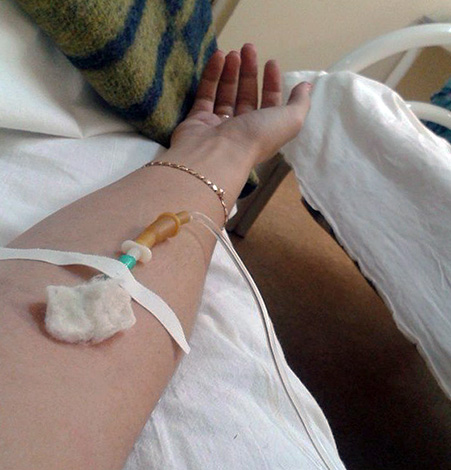
At the height of the disease, the symptoms of encephalitis can vary greatly, depending on its form. In turn, the form will be the heavier, the more the virus multiplies in the nerve cells.
In the mildest form, feverish, the symptoms of brain damage are completely absent, and only standard infectious manifestations are observed. Therefore, this form of encephalitis can sometimes be confused with the flu.
The most common form of CE - meningeal - is similar in symptoms with meningitis. Patients suffer from severe headaches, they have increased intracranial pressure and photophobia is present. This changes the composition of the cerebrospinal fluid.However, the meningeal form, for all its danger, also responds well to treatment.
The disease is especially severe in the meningoencephalitic form, which has a high mortality rate. Multiple small hemorrhages are found in the brain, gray matter dies off, and convulsions and seizures are observed. Recovery is possible, but it can take years, and it is very rare to fully restore health. Due to necrosis of brain tissue, a decrease in intelligence can develop, leading to disability and the development of mental disorders.
There are other forms of tick-borne encephalitis - poliomyelitis and polyradiculoneuritis. In this case, the virus is localized mainly in the spinal cord, causing a complex of motor disorders. This may be tingling or numbness of the muscles, feeling of "running goosebumps", weakness of the limbs. With an unfavorable outcome, the disease can result in paralysis and death.
Statistics show that about a third of patients who had symptoms of severe damage to the nervous system, fully restore their health. We are talking about all of the above encephalitis forms.At the same time, mortality for severe forms of the disease ranges from 20 to 44% percent, depending on the region. A separate group of cases (from 23 to 47%) - people who have pronounced consequences after an illness, including people with disabilities.
The photo below shows the effects of tick-borne encephalitis (atrophy of the muscles of the shoulder girdle on the background of the poliomyelitis form of TBE):

With this in mind, it becomes quite obvious that for any obvious signs of impairment of the tick-borne encephalitis during the incubation period, it is necessary to deliver the tick-bite victim to the doctor as soon as possible to clarify the situation and start treatment. The sooner the treatment begins (if required), the lower the risk of possible serious consequences of CE.
Tick-borne encephalitis treatment
The main method of treating a disease is a course of injecting specific anti-encephalitic gamma globulin. This substance is a protein from a class of antibodies that neutralizes tick-borne encephalitis virus particles in the body, preventing them from infecting new cells. The same immunoglobulin is set for emergency prevention of the disease.

Often in the treatment of using and ribonuclease - a special enzyme that "cuts" the strand of RNA (and this is the hereditary material of the virus), blocking its reproduction. If necessary, the patient can prescribe interferon - a special protein that enhances its own protection of cells against damage by viral particles.
Usually there is no need to use all three drugs at once, but such a need may appear when a severe form of the disease develops.
Despite the level of severity of symptoms, all patients with tick-borne encephalitis show strict bed rest. The more a person moves, especially in the initial period of the disease, the higher the chance of getting complications. Any increased intellectual activity in the acute period of the disease is also prohibited. At the same time it is important to increase the duration of sleep, there is a diverse and sufficiently high-calorie food.
Normally, the patient must be treated in the hospital from 14 to 30 days. The minimum duration of treatment of EC is required for the mildest (febrile) form of the disease, the maximum - for meningeal disease - from 21 to 30 days.
After this time, patients usually recover fully and can return to normal life.However, for two months after recovery, it is worth choosing for yourself the most benign regimen of the day, not to overwork. The body will still need time to fully recover.

For more severe forms of tick-borne encephalitis, the period spent in hospital is in the range of 35-50 days. The patient can both be completely cured and get serious complications in the form of motor impairment, muscle numbness, mental disorders.
Renewal of well-being in such cases can take from six months to several years, and sometimes the effects of encephalitis remain with a person for life.
It is important to know
Stable positive dynamics in the first days of treatment still does not guarantee recovery. There is a two-wave form of encephalitis, when, after a week of imaginary improvement, a new acute febrile period begins. Therefore, during treatment it is necessary to strictly adhere to the recommendations of the doctor to avoid relapse. With the right actions of the patient in most cases, there is a full recovery, but for this it is important to treat the interaction with the doctor as responsibly as possible.
Incubation period of other tick-borne infections
Ticks carry not only tick-borne encephalitis, and therefore, if a parasite bite occurred, it is useful to have an idea of the possible symptoms of other diseases:
- Lyme disease (tick-borne borreliosis) is quite common throughout Europe, and in some regions is diagnosed even more often than encephalitis. With borreliosis, the incubation period averages 1-2 weeks, but sometimes it shortens to several days or lengthens to a year or more (such cases are rare, but known). The first manifestations of the disease are similar to those with encephalitis - the temperature rises, there is a fever, sore throat, muscle aches. In general, this is the beginning characteristic of most infectious diseases. However, with Borreliosis, almost always patients have one specific feature - the tick bite site is modified and looks like ring-shaped redness. In the future, it can grow in size. In the center, the redness is lighter than at the edges, and often appears even before the main symptoms. Thanks to this, Lyme disease can be identified even before the results of professional diagnostics. The photo below shows this redness (also called erythema migrans):
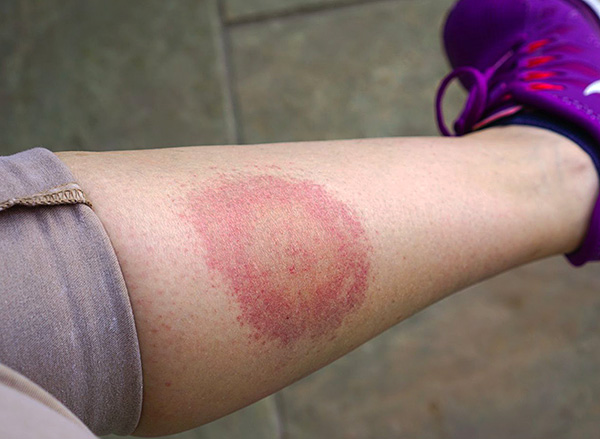
- Tick-borne typhus is a disease more characteristic of the Siberian zone. The incubation period is very short, only 2-5 days, maximum week. It begins with acute fever, which may give similarities with encephalitis. However, very soon after the onset of the disease, the patient develops a pink-colored rash with ulcers in the middle. This rash spreads over the entire body. The disease is dangerous because, like tick-borne encephalitis, it can affect the nervous system. Hospital treatment is required;
- Tularemia is a disease prevalent in temperate northern latitudes around the globe. Ticks are not the main carriers of this disease, but there are known cases of infection from them. The incubation period of the disease averages 3-7 days, and the maximum known lasts 3 weeks. Tularemia begins as acutely as previous infections: fever, headache, dizziness, sometimes with vomiting and nosebleeds. In most patients, the disease is accompanied by conjunctivitis from the very first days. A special characteristic of tularemia is a significant increase in lymph nodes, which can swell up to 5 cm in diameter. Also characteristic is the formation of fistulas, which is not the case with tick-borne encephalitis.
In general, the most dangerous period after a tick bite is two weeks. Given the possible fluctuations in the duration of the incubation period, it would be best to monitor the condition of the affected person for 21 days after removing the tick. Of course, there were precedents and later manifestations of disease after a bite, but these cases are very rare. Therefore, if three weeks have passed after the tick attack, and everything is fine with the state of health, then we can quite confidently assert that no infection has occurred.
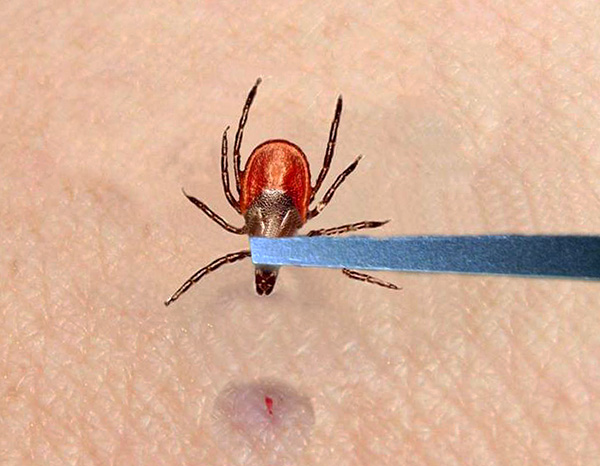
Despite all the danger of tick-borne encephalitis and the need to monitor its condition after a tick bite, it should be borne in mind that, fortunately, infection occurs quite rarely. Not all ticks carry encephalitis even in areas endemic for this disease. For example, in Siberia and the Far East, only 6% of ticks are infected with a virus.
In addition, it is shown that among people bitten even by infected ticks, only 2 to 6% get sick - the rest of the virus either does not have time to enter the body (for example, if the parasite was removed at the beginning of bloodsucking) or is destroyed by the immune system.The percentage of asymptomatic disease progression is also taken into account.
Most often, those who have been bitten are infected. Such risk groups include tourists, foresters, hunters - these people can regularly take off from 5-10 ticks. If a person is bitten by a tick, the risk of getting sick is minimal. Most likely, after such a bite, nothing terrible will happen, so you should not panic. But it is imperative to observe your well-being, just as you need to see a doctor if there are obvious symptoms of the disease during the standard periods of the incubation period.
Useful video: how to recognize tick-borne encephalitis in time and what is important to know about this disease
Examples of effects of tick-borne encephalitis

